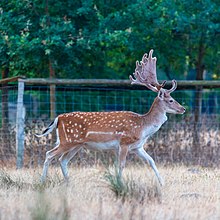Fallow deer
| Fallow deer Temporal range:
| |
|---|---|

| |
| European fallow deer (D. dama) | |
| Scientific classification | |
| Domain: | Eukaryota |
| Kingdom: | Animalia |
| Phylum: | Chordata |
| Class: | Mammalia |
| Order: | Artiodactyla |
| Family: | Cervidae |
| Subfamily: | Cervinae |
| Tribe: | Cervini
|
| Genus: | Dama Frisch, 1775 |
| Type species | |
Cervus dama [1] Linnaeus, 1758
| |
| Species | |
| |
| Synonyms[2] | |
| |
Fallow deer is the common name for species of deer in the genus Dama of subfamily Cervinae.[3]
Name
The name fallow is derived from the deer's
Taxonomy and evolution
The genus includes two extant species:
Extant species
| Common name | Scientific name and subspecies | Range | Size and ecology | IUCN status and estimated population |
|---|---|---|---|---|
| European fallow deer | Dama dama (Linnaeus, 1758) |
Confirmed native only to Turkey, but possibly native to the Italian Peninsula, the Balkans, and the island of Rhodes in Greece; introduced from Roman times onwards to the rest of Europe, and around the world in more recent times
|
Size: Habitat: Diet: |
LC
|
| Persian fallow deer | Dama mesopotamica (Brooke, 1875) |
Iran and Israel; once ranged throughout the Middle East and eastern Turkey
|
Size: Habitat: Diet: |
EN
|
Some taxonomists classify the
The earliest species of Dama appeared around the Pliocene-Pleistocene boundary approximately 2.6 million years ago,[7] or around the beginning of the Middle Pleistocene approximately 0.8 million years ago,[8] depending on the species included in the genus. The relationships of most Dama species to each other and to other fossil deer are controversial, with no overall consensus on their relationships, aside the close relationship of D. clactoniana with the living Dama species. The earliest Dama species lack palmate (broad and flattened) antlers, with this trait only developing in D. pelleponesica, D. clactoniana, and the two living species.[6]
Extinct species, based on van der Made et al. 2023:[6]
- Dama nestii known from the Early Pleistocene of Europe, also assigned to the genus Pseudodama.[7]
- Dama vallonnetensis known from the Early Pleistocene of Europe,[6] also assigned to Pseudodama.[9]
- Dama farnetensis known from the Early Pleistocene of Europe,[6] also assigned to Pseudodama.[10]
- Azokh Cave in Azerbaijan. Species not universally recognised as valid.[6]
- Dama roberti known from the early Middle Pleistocene of Europe.[10]
- Dama celiae known from the Middle Pleistocene of Spain[6]
- Dama clactoniana, known from the late Middle Pleistocene of Europe, thought to be the ancestor of the two living species.[6]
Relationships of Dama to other deer species based on mitochondrial DNA.[11]
| Cervidae |
| |||||||||||||||||||||||||||||||||||||||||||||||||||
References
- ^ OCLC 62265494.
- ^ "Dama". Global Biodiversity Information Facility. Retrieved 2024-02-04.
- ^ "The IUCN Red List of Threatened Species". IUCN Red List of Threatened Species.
- ^ Saltz, David; Rabiei, Alireza; Daujat, Julie; Baker, Karis; Noam Werner (IUCN SSC Deer SG / General Curator EAZA Deer TAG Chair, The Tisch Family Zoological Gardens (July 25, 2015). "IUCN Red List of Threatened Species: Dama mesopotamica". IUCN Red List of Threatened Species.
- PMID 26052672.
- ^ ISSN 1866-9557.
- ^ PMID 35974071.
- ISSN 1867-1594.
- ISSN 0375-7633.
- ^ .
- ISSN 0071-3260.




